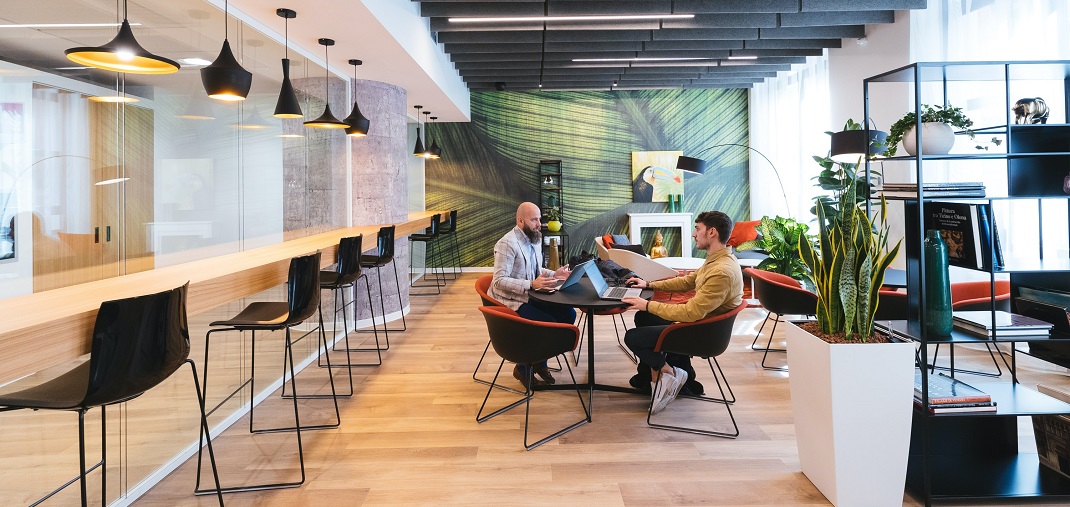Coworking Market Outlook
Since 2010, according to JLL research, the inventory of flexible workspace has been increasing at an annual average rate of 23%. Thanks to the combination of strong venture capital investment and the growing popularity of hybrid work, the coworking business model is a key primary revenue generator.
Recent analysis conducted by Coworking Resources found that 77% of coworking operators intend to grow their network and projected that flexible office spaces would number more than 40,000 and house five million workers globally by 2024 — an increase of 158% from 2020. Office owners are also taking advantage of the opportunity, by developing their own flexible spaces, or collaborating with coworking operators in an effort to increase occupancy and generate additional cash flow.
What’s more, coworking has been playing a bigger part in the strategies of office occupants, as well. The CBRE Occupier Sentiment Survey conducted in spring 2022 highlights that 51% of corporate real estate executives predicted flex space would make up 10 to 50% of their office footprint within the next two years, and an additional eight percent stated they aim to have flex spaces account for more than half of their portfolio.
Although acting more as a catalyst rather than the initial spark, the pandemic has undoubtedly paved the way for the coworking phenomenon to expand and mature — COVID has only accelerated the trend that had been on the upswing for more than a decade.
In addition to expediting the transition, this health crisis also proved that remote and hybrid working arrangements are mutually beneficial for employers and employees: workers have more freedom to choose where and when they do their jobs, and employers can adapt more quickly while keeping better stock of the bottom line.
Landlords, too, have been positively impacted by this ongoing redefinition of the workspace — the sudden increase in demand for more flexible solutions, along with appetites shifting away from the traditional office space, have created new challenges and a race to better leverage changing market dynamics.
Commercial Property Executive asked industry experts about the challenges and opportunities brought about by the changing landscape, and whether flex space will become standard in office properties as the “new normal” consolidates.
 Brendan McGee, director of worCPlaces — CP Group’s coworking business unit — reckons that flexible offices are, above all, a means for companies to offer value, choice, and flexibility to their employees. “These are the main traits that heralded the rise of popular coworking brands over the past decade,” he said. “The global pandemic magnified the importance of these attributes and turned every business into a potential coworking or flex office customer.”
Brendan McGee, director of worCPlaces — CP Group’s coworking business unit — reckons that flexible offices are, above all, a means for companies to offer value, choice, and flexibility to their employees. “These are the main traits that heralded the rise of popular coworking brands over the past decade,” he said. “The global pandemic magnified the importance of these attributes and turned every business into a potential coworking or flex office customer.”
 THRIVE Coworking CEO and founder, Ramon Gonzalez, says the shift is giving employees a louder voice as a consequence of talent shortage, and companies have been more motivated to prioritize the needs of their workers. “We have gone through a season where with employers and employees, there has been a power shift. I think overall that is a positive trend if you think about where we come from in terms of how work has been done up until now. It is much more employee centric.”
THRIVE Coworking CEO and founder, Ramon Gonzalez, says the shift is giving employees a louder voice as a consequence of talent shortage, and companies have been more motivated to prioritize the needs of their workers. “We have gone through a season where with employers and employees, there has been a power shift. I think overall that is a positive trend if you think about where we come from in terms of how work has been done up until now. It is much more employee centric.”
 Beth Moore, head of strategic growth at Raise Commercial Real Estate, adds that “Offsite is the new onsite” has become a new catchphrase in the office sector. For example, many office tenants that have adopted coworking environments are allocating the cost savings toward offsite events to bring employees together outside of the office.
Beth Moore, head of strategic growth at Raise Commercial Real Estate, adds that “Offsite is the new onsite” has become a new catchphrase in the office sector. For example, many office tenants that have adopted coworking environments are allocating the cost savings toward offsite events to bring employees together outside of the office.
Diversification Yields both Safety & Growth Potential
Experts assert that there is compelling justification for including flexible space in an office portfolio, given how paradigms for office work are still evolving.
Gonzalez explained that any office property benefits from stability and growth if there’s a range of different end users on its tenant roster. “A coworking space is a collection of businesses in the local community. If you have an asset that is in a market that is vibrant and in an economy that is strong, you are more diversified having, say, 20 to 40 companies occupying your floor, versus having single-tenant risk.” Additionally, Gonzalez argued that coworking operators are reliable long-term tenants. “We don’t want to go through the process of relocating.” Both coworking operators and their members tend to be more motivated to expand in place rather than move to a different building.
As the number of coworking spaces have grown over the past decade, their client profiles have also diversified. “While previous iterations of coworking spaces were targeted at solo gig workers and small-to-medium sized businesses, recent trends show more enterprise companies utilizing coworking spaces as they pivot toward flexibility and offering their employees more options about where and how they work,” Brendan McGee said. “Coming out of the pandemic, C-suite executives are more open to the value that coworking offers and are more inclined to suggest coworking as a solution to both control their bottom line and drive worker wellness and productivity”. McGee also calls attention to another related trend — enterprise-level real estate businesses adopting the coworking model under their own brands.
Beth Moore confirmed both perspectives and stated that giving space for flex offices in a building may not only be a safeguard against single-tenant risk in the long run but may actually help foster the loyalty of current tenants. “Some landlords are creating their own brands of coworking space. Others are looking at their portfolio and saying, ‘Hey, my building stack doesn’t have a flexible option. If I have a flexible option, it will increase the likelihood of tenants I already have in my building staying in my building for longer,” Moore noted.
Landlords Weighing Their Options — Enterprise Tenants in Traditional Offices Are a Natural Fit for Flex Adaptations
Although owners and managers of all property types are remodeling spaces to attract coworking space operators, office space is obviously the best candidate, even if it needs adjustments. According to James Davison, co-founder and CEO of The New Design Project, most landlords are increasingly embracing flexible spaces as the future of work, Commercial Property Executive reported in September. Davison stated that operators would eventually outcompete traditional office landlords for tenants if they do not include coworking spaces in their portfolio. Therefore, landlords are now facing critical decisions about how or if to add flexible space to their buildings.
How Coworking Operators Choose Buildings for Their Next Locations
Beth Moore said operators put a lot of effort into evaluating which property best fits their brand, based on the building’s current state. “When operators are going into new buildings, they have a list of predefined criteria that helps them narrow down which building they are going into,” she noted. From the size of the floor plate to the windows, restrooms, and elevators, all aspects are taken into account. Sometimes, the floor plans of pre-existing offices are not designed to support the necessary load factors for restroom and elevator capacity needed by a coworking space.
The traffic flow of buildings often needs upgrading. Similarly, the problem of acoustics can often be addressed during flex space renovations — improved noise isolation becomes necessary with the shift to a fully collaborative environment, as traditional offices are rarely developed to handle the amount of simultaneous meetings and kitchen noises that are considered normal in a coworking space. For coworking clients, designated places for food and refreshments are also very appealing. Operators frequently expand the spaces as much as possible and include more amenities than in a normal office space.
Having gone through both office renovations and adaptive reuse projects at THRIVE, Ramon Gonzales points out that while remodeling a historic structure might produce a stunning end result, it takes more time and money than turning existing office space into a flexible work environment. “In terms of optimizing layout, it is more economical to do a conversion if there is already lots of infrastructure in place,” he said. However, he also believes that the currently undersupplied suburban markets and lifestyle destinations will see a considerable increase in the amount of space delivered in the near future, implying that we’ll see more conversion projects based on non-office properties as the market expands.
According to Brendan McGee, coworking becomes a desirable option in CP Group’s strategy when tenants signal their need for greater flexibility and readymade solutions due to fast-changing headcounts and rapid growth predictions. The coworking subsidiary of CP Group, which opened its doors in August 2021, converted traditional offices to flexible spaces based on feedback from its clients. Their first in-house, owner-operated location is a full-floor transformation in an Atlanta building — the project features a conventional coworking model called CoWork Places, as well as five apartments that can hold teams of 10 to 30 people. “We have additional locations planned across our portfolio. Our goal is to have as much as 10% of our 18 million-square-foot portfolio operate as coworking/flex,” McGee added.







